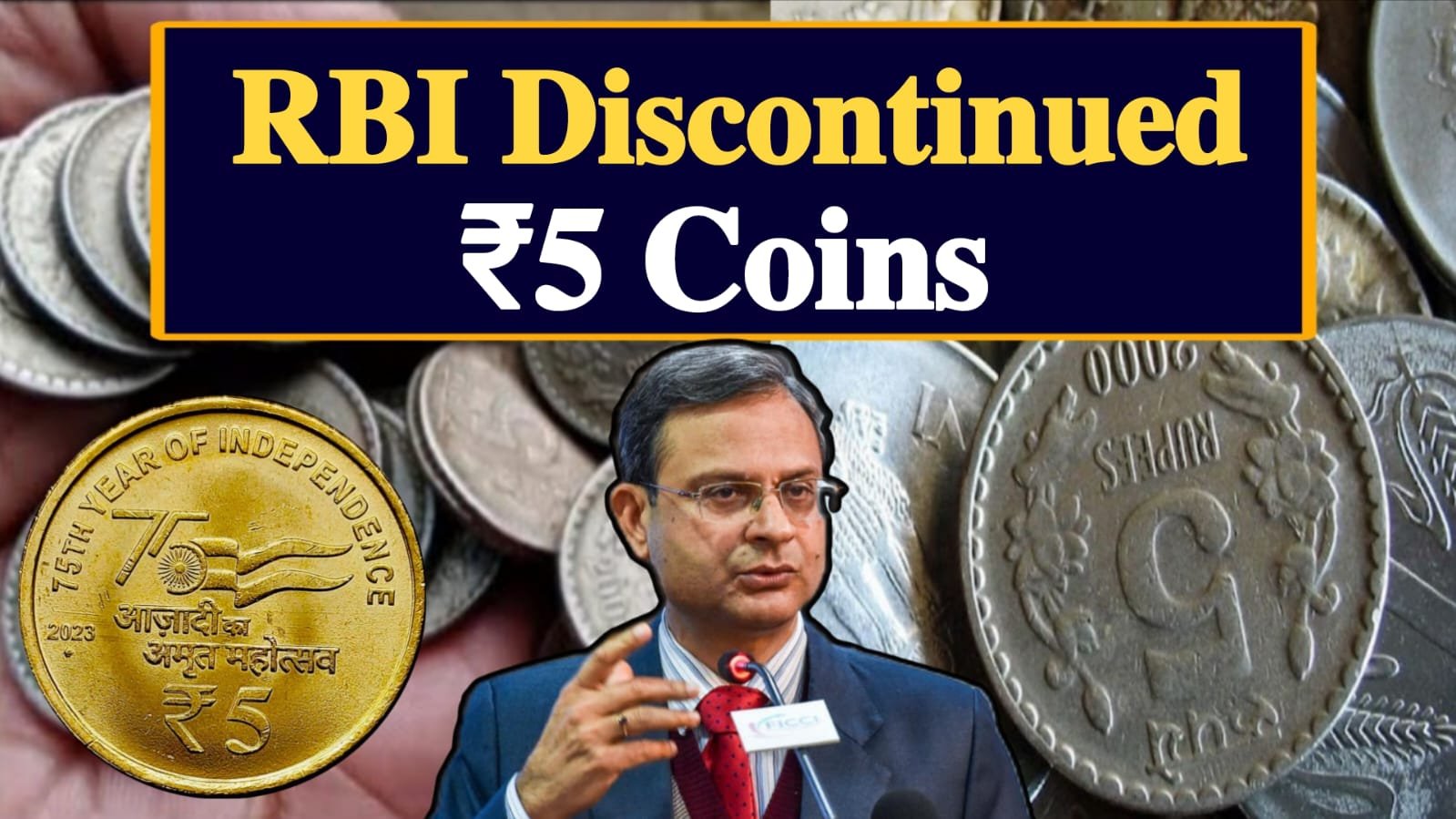5 Rupees Coin RBI Update : If you still have ₹5 coins in your possession, this news is especially important for you. Recently, there has been widespread discussion and speculation regarding the discontinuation of ₹5 coins by the Reserve Bank of India (RBI). With the increasing circulation of social media posts and news suggesting changes in the status of these coins, it is crucial to understand the actual facts, the RBI’s decision, and the reasons behind it. Let’s dive into the details.
5 Rupees Coin RBI Update : Current Status of Coins in Indian Currency
As of now, Indian currency includes coins ranging from ₹1 to ₹20 and paper notes from ₹1 up to ₹500. Among the coins, ₹1, ₹2, ₹5, ₹10, and ₹20 are commonly circulated across markets. However, over the past few years, the appearance and composition of these coins have undergone multiple changes — particularly the ₹5 coin, which has seen significant alterations in terms of size, weight, and material.
These modifications have not gone unnoticed. Many people have observed a decline in the circulation of the old, thicker ₹5 coins, while newer, thinner versions — often made of different metals — have become more common.
5 Rupees Coin RBI Update : Has the ₹5 Coin Been Banned by RBI?
Contrary to some rumors circulating on social media, the RBI has not entirely banned the ₹5 coin. However, it has phased out the older versions of the coin — particularly the ones that were thick, heavy, and made of high-value metals. These old ₹5 coins are no longer being minted and are slowly being withdrawn from circulation.
The reason behind this decision is not just aesthetic or related to modernization, but actually stems from a serious economic and security concern involving the misuse of these coins.
5 Rupees Coin RBI Update : The Bangladesh Connection: Illegal Melting of ₹5 Coins
One of the key reasons why the old ₹5 coins are being discontinued relates to their metal composition. The earlier versions of the ₹5 coin contained a relatively high quantity of valuable metals, making them worth more when melted down than their actual face value.
Reports have revealed that these coins were being illegally smuggled to Bangladesh, where they were melted and used to manufacture blades (razor blades) and other metal products. The economics of this operation were surprisingly profitable. For instance:
-
A single ₹5 coin, when melted, could yield metal sufficient to manufacture blades worth up to ₹12 in value.
-
The melted material could be used to make multiple blades, each selling for around ₹2.
This essentially turned ₹5 coins into a black-market raw material, being used in a way that undermined the integrity of Indian currency and posed a threat to the economy.
5 Rupees Coin RBI Update : Surface Value vs Metal Value of a Coin
To understand this issue further, we must distinguish between two key concepts: surface value and metal value of a coin.
-
Surface Value: This is the face value or the amount written on the coin. In the case of these coins, it is ₹5.
-
Metal Value: This refers to the value of the metal(s) used in the coin when melted down and sold.
With the older ₹5 coins, the metal value had exceeded the surface value. This meant the coins were worth more as scrap metal than as currency. This economic imbalance encouraged illegal activities such as smuggling and melting of coins.
5 Rupees Coin RBI Update : RBI’s Response: Changing the Coin’s Composition
Upon discovering the scale of this illegal trade and the resulting shortage of ₹5 coins in the domestic market, the RBI and the Indian government took swift action. Rather than removing the ₹5 denomination altogether, the RBI decided to change the composition and design of the coins.
Here are the key changes that were introduced:
-
The metal composition was altered to include cheaper and less valuable metals, thus reducing the metal value of the coins.
-
The thickness and weight of the coins were significantly reduced.
-
Newer ₹5 coins now appear thinner, lighter, and are often bimetallic or made with alloys that have minimal scrap value.
By doing this, the RBI ensured that even if someone tried to melt these newer coins, they would not gain any economic benefit, thereby curbing illegal activities.
Are Old ₹5 Coins Still Legal Tender?
While older ₹5 coins are not being minted anymore, they still remain legal tender unless officially demonetized by the RBI — which has not yet happened. You can continue to use them for transactions, although their circulation is declining.
However, due to hoarding, smuggling, or melting, many of these coins are no longer commonly seen in everyday transactions. You might notice that most ₹5 coins you encounter now are of the newer, thinner variety.
If you still possess old ₹5 coins, you can either use them for regular purchases or deposit them at your local bank.
Implications for the Public
The move to phase out old ₹5 coins and replace them with newer ones carries a number of implications:
-
For the General Public: There is no immediate cause for concern. The coins in your possession are still valid unless stated otherwise. However, it’s advisable to start using or depositing older coins as their acceptance in the market may reduce over time.
-
For Businesses: Vendors, shopkeepers, and transport operators should stay informed and avoid rejecting valid coins, as doing so is illegal and can lead to penalties under the Coinage Act.
-
For Collectors: Old ₹5 coins may become collectible items in the future, especially if they are part of special editions or have rare mint markings.
Conclusion : A Strategic Move to Protect Currency Integrity
The RBI’s decision to discontinue the older ₹5 coins is a strategic and necessary move aimed at preserving the integrity of the Indian currency system. By addressing the exploitation of coin metals and preventing illegal cross-border smuggling, the RBI has demonstrated a proactive approach to currency management.
In summary:
-
Old ₹5 coins are being phased out due to their misuse and high metal value.
-
New coins have been introduced with safer and cost-effective materials.
-
These changes are meant to protect the economy and ensure coins are used as intended — not as raw material for profit.
So, if you still have ₹5 coins, especially the older, heavier ones — you may want to spend or deposit them while they are still in circulation. And if you come across social media posts claiming a total ban, be cautious — not all viral content is accurate. Always refer to official RBI communications for verified updates.



